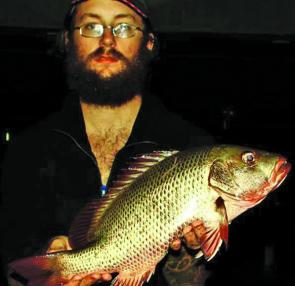It’s summertime again and one thing that most anglers are excited about are mangrove jacks. These fish provide anglers, especially juniors, with the ultimate fishing challenge.
Good tackle and a good strike will be essential to get these fish into the net. It is a good thing for junior anglers to start targeting larger and more challenging fish, because it can teach a whole lot about the tackle needed, how to hook more fish and will make a young fisherman wanting to go back again and again.
In the estuaries/rivers, mangrove jack tend to be a reddish-brown colour all throughout the body, and have a similar body shape to a bream. Most anglers will catch these fish around 1-3kg, but jacks have been known to be caught around 10kg!
The legal size to keep these fish is 35cm, with a bag limit of five fish. They can be caught along the coast, in the upper river reaches, and reef systems.
When looking for a good spot for these fish, look for mangrove systems, rocks, bridge pylons, fallen trees, or wherever you think there is good enough structure for mangrove jack to hunt. At the moment, many jacks are being caught around the upper reaches of the Noosa River, Mooloolah River, and small creeks and inlets running off these rivers.
Mangrove jack can be caught all throughout the year, but the warmer summer months are when the jacks are definitely most active. Younger fish will live in the estuarine systems until they reach about 3kg, then they will start to move seaward as they grow larger. If you have a boat, or have access to one, trolling lures such as shallow diving minnows past snags and mangroves, usually results in a decent jack.
If fishing off the bank, find the jack territory, and cast a live bait out, this can be live mullet or herring which just might give you great results with a large jack smashing it! While your live baits are sitting out in the water, if another rod is available, have a cast around the snags trying out your lures, you never know if a jack or any other might strike.
Anglers fishing for bread and butter species like bream sometimes will happen to reel in a jack, which can be quite surprising. But, if you’re up to the challenge and want to catch larger fish then it is a good idea to use heavier tackle.
Good, strong rods, reels and lines are essential when fishing for jacks, mainly to keep them from running right back into the snags and snapping the line.
The line size that is appropriate when targeting these fish should be between 8kg-12kg and trace should be quite heavy. If fishing with baits or live baits, use a small sinker and a 2/0 to 4/0 shortshank hook.
If a fish strikes hard and fast in these areas, it will most likely be a jack. Hooking the fish instantly is key, because it will take one strike and head straight back in the snags.
Once hooked, remember to have the drag set to an appropriate level: you need to keep the fish out of the snags, but must give the fish a bit of line to prevent bust-offs.
If you think you have got the fish close to either your boat or the bank, ask your family or friends to have a net ready. If it turns out to be a mangrove jack, it will be a very happy moment, but remember the safety precautions. These fish have sharp spines, and sharp teeth, so take a lot of care while handling.
Mangrove jack are a great fish to target when a junior angler wants to take their fishing up another level, and great for a ‘family and friends’ fishing day out. Remember all the tackle needed, safety precautions, and you will be set for your next trip. If you find the jack territory, and you get a good amount of fish, don’t forget your camera!
Even if your day doesn’t result in any mangrove jacks, then don’t be disappointed, because fishing for species like this one can be a good, tough, but fun challenge for most junior fishers each time.
Reads: 3965
My mate Matt Fisher with a 2kg Mangrove Jack, taken on the Sunshine Coast on a livebait.




